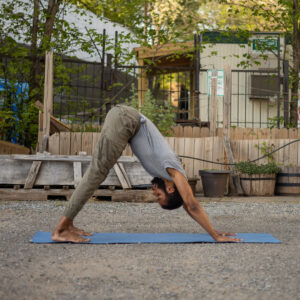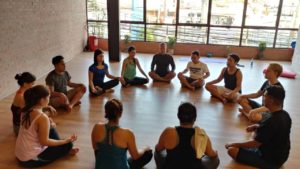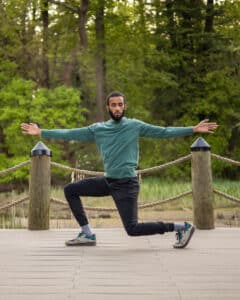Ever thought about becoming a yoga teacher? Or at the very least, wondered what happens during teacher training? Is it non-stop yoga classes, will there be a sense of community, will I just learn a bunch of yoga poses or is there much more to it?
Join Aaron, a Yoga District’s teacher trainee, as he shares his current teacher training experiences through a series of posts. Find out what happens in yoga teacher training and if it might be something you would want to try yourself.
A NEW CHAPTER
Last week I started Yoga District’s 200-hr Yoga Teacher Training. And as our class begins the process of peeling back the many layers of yoga, as it’s described in The Yoga Sutras of Patanjali, I can’t help but feel an immense sense of joy and gratitude (1).
Now that I’m in the program, I have a good idea of what to expect going forward. But leading up to it I had a ton of questions:
- Should I do this if I’m still undecided about wanting to teach?
- If so, what yoga studio should I do the training in?
- What does a typical day in teacher training even look like?
My list of questions went on and on. Googling did help a bit but I wasn’t always able to find the answers. So over the next couple of months I’d like to share my own journey through Yoga Teacher Training (YTT) with the hopes that it might help answer some of those questions for people curious about doing it themselves one day.
IS YTT RIGHT FOR ME?
Before I dive into what YTT is like, I want to talk about the first step. And that’s deciding if making the investment of doing a YTT is something you want to do or not.
When I was trying to answer this question for myself, I worried that if I found out that teaching wasn’t for me, then my YTT somehow wouldn’t be considered a “success”. But after researching other’s journeys I realized YTT isn’t only for people who want to teach.
Finding this out gave me a sense of relief and helped me enjoy the prospect of doing a YTT even if the outcome was just deepening my own practice. Especially because in the past I’ve had to stop doing yoga altogether because of injuring my elbow after practicing yoga in an anatomically unsafe way. I figured if I can come out of YTT just learning how to have a safe practice that allows me to do yoga for the rest of my life then that alone would be worth the investment.
 Lo and behold, one of my favorite parts about YTT so far are the pose breakdowns. During class, the teacher will take a pose from our workbook and teach us how to do them (and cue them for other people) in a safe way. An example, for Downward-Facing Dog (Adho mukha svanasana) one of our teachers explained to us how to distribute our body weight into the palms of our hands in a way that relieves unnecessary pressure from the delicate wrist joint.
Lo and behold, one of my favorite parts about YTT so far are the pose breakdowns. During class, the teacher will take a pose from our workbook and teach us how to do them (and cue them for other people) in a safe way. An example, for Downward-Facing Dog (Adho mukha svanasana) one of our teachers explained to us how to distribute our body weight into the palms of our hands in a way that relieves unnecessary pressure from the delicate wrist joint.
So if you’re unsure if you want to teach yoga, I wouldn’t let that stop you. Maybe you’re on the fence like me and okay using the opportunity to deepen your own practice. Or, something else like having the opportunity to meet other people in the community that share your passion for yoga.
Whatever that personal reason looks like for you, I do invite you to explore that reason because doing a 200 hour training program is a commitment. And when you have to show up for a 6 hour yoga training after a long day, being able to come back to that “why” makes it easier to be present and have a positive experience.
PICKING A STUDIO
If you do decide that doing a YTT is something you’re interested in, the next part is finding a studio. Typing “Yoga Teacher Training” into Google’s search engine is one way to go. But, there are a lot of options out there.
Two things that helped me narrow my search down are:
- Knowing it’s possible to reap all the benefits of a YTT without going to a far-off location.
- There’s always the opportunity to do more than one YTT in case there’s something else you want to learn.
What might be worth giving importance is finding a place where you’re comfortable and the training aligns with your values.
 I chose Yoga District because I’ve grown comfortable with the community through years of practicing there. And I got a sense from Yoga District’s teachers and the teacher training application that the program would go beyond teaching postures to incorporate other aspects of yoga like breathing, meditation, and philosophy too. This was important to me because it wasn’t until I practiced yoga holistically that I started to find physical and psychological relief from pain that plagued me for years.
I chose Yoga District because I’ve grown comfortable with the community through years of practicing there. And I got a sense from Yoga District’s teachers and the teacher training application that the program would go beyond teaching postures to incorporate other aspects of yoga like breathing, meditation, and philosophy too. This was important to me because it wasn’t until I practiced yoga holistically that I started to find physical and psychological relief from pain that plagued me for years.
It can be really helpful to keep in mind what you’re looking for in a training. I was in my ultimate happy place, on our first day of training when we learned different ways to sit comfortably on the floor for meditation and then segued into a 30 minute meditation. But I recognize that this would have been a challenge for me if I were looking for a training program strictly focused on the asana part of yoga. So this is something that’s definitely worth taking into consideration. And if it’s hard to tell, maybe just reach out to one of the teachers at the studio and see if they can help.
A DAY IN YTT
In terms of what a typical day of YTT looks like, no two days are the same as the classes have different teachers. And each teacher has their own unique way of instruction based on their background, expertise, and preferences.
Due to current circumstances, my particular YTT is a hybrid program. Two days out of the week we meet online for 3 hours in the morning and 3 in the evening. Then on Saturday, we meet in-person at a studio for about 7 hours with a lunch break.
A common structure for any given class is something like:
 Mediation
Mediation
- Each training session normally starts with about 25 minutes of seated meditation consisting of 5 minutes of AUMs, 5 minutes of Bhastrika, 5 minutes of Kaphalabhati, 10 minutes of calming breath, and then 5 minutes of “So Hum” mantra-based meditation and finally closing with another round of AUMs (2, 3, 4, and 5).
- We’re encouraged to do these morning meditations even outside of the 3 days we have class. If you haven’t tried it before, I think it’s worth giving it a shot. I’ve found that it’s a nice way to start the day in a mindful way. And, afterwards it helps me set a grounded calm cadence for the rest of the day. If 30 minutes isn’t available, you could always change the duration to something that fits your schedule.
- Pro tip: The “Insight Timer” app has a timer feature with the capability to add intervals. You can meditate for 30 minutes and be notified when to switch to the next meditation style every 5 minutes. If you set this up in the app then you could continue to meditate without having to worry about looking at your device.
Class Begins
- If the teacher is new, the class introduces themselves. Our training program has 8 teachers total.
- Then the instructor will cover a certain concept related to teaching. This can be anything from yoga outreach, to creating a sequence for a class. Or detailing the history of yoga so that we can be mindful of cultural appropriation as we share yoga with others (6).
 Teacher Self-Care
Teacher Self-Care
- For instance during one day of training, our instructors took the time to guide us on how to take care of ourselves as teachers. Through reading and conversation we learned that if we don’t take care of ourselves then we won’t be able to effectively share yoga compassionately with others.
- For me this point really hit home. My favorite yoga teachers are the ones that carry an essence of calm confidence in their class. And I can only imagine if they (or one day, me) were to be in a place of needing self-care then how this could disrupt the ability of a student to get the most out of their practice with the teacher.
Teaching Exercises
- I’m going to talk a lot more about teaching exercises in one of my future posts. But from the very first week we’re invited to actually start teaching.
- I mentioned earlier about being unsure if teaching is something I want to do. That said, I found the experience of having to instruct my classmates through a sequence fun and a great confidence builder. Even better, as someone who is curious about teaching, it forces me to verbalize to other people how to move unharmed between postures. And having the opportunity to practice teaching in a safe environment with my classmates who are also learning is a joyful experience.
WHAT’S TO COME
There’s still so much to cover. Next time I’ll delve into what it was like meeting my class in person and our sense of community
Also, throughout the training, we’re scheduled to dive deeper into the benefits of meditation and break down more poses in depth. I look forward to sharing all that and more in the weeks to come!
Sources:
- The Yoga Sutras, https://www.goodreads.com/book/show/56305.The_Yoga_Sutras
- AUM, https://www.yogapedia.com/definition/4957/om
- Kapalbhati Pranayama, https://www.yogapedia.com/definition/6469/kapalbhati-pranayama
- Bhastrika Pranayama, https://www.yogapedia.com/definition/6438/bhastrika-pranayama
- So Hum: Contemplation Meditation, https://www.yogajournal.com/meditation/so-hum-contemplation-meditation/
- History of Yoga, https://www.yogajournal.com/yoga-101/the-roots-of-yoga/


